June 2021 TheShift e-newletter
More Sustainable R&D: Address Impacts Early with Anticipatory LCA
Free Webinar—An Anticipatory LCA Approach to Evaluate & Improve the Climate Benefit from Emerging Carbon Capture & Utilization (CCU) Technologies
Thursday, June 10, 2021—1:00pm EDT
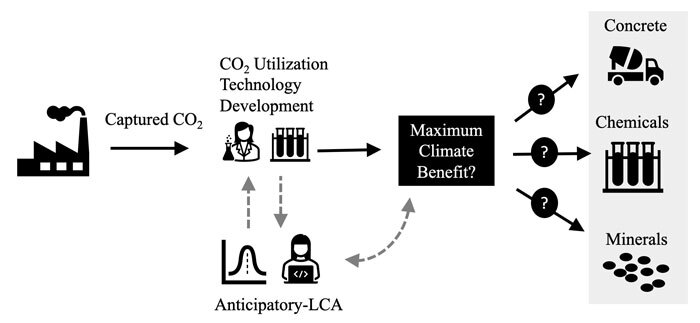
The capture and utilization of carbon dioxide to generate products such as concrete and chemicals is an economically and environmentally promising approach to address climate change. There has been a significant increase in R&D expenditure and efforts to commercialize carbon capture and utilization (CCU) technologies. With CCU operations expected to increase in scale globally, there is a vital need to combine the technology development with environmental assessments to ensure that only those emerging CCU technologies which generate a net climate benefit on a life cycle basis are commercialized.
This talk will demonstrate the application of the anticipatory-LCA approach to evaluate and improve the climate performance of 20 emerging CCU technologies which produce concrete, chemicals and minerals. Using the anticipatory-LCA approach, a novel climate return on investment (ROI) metric is applied to rank the 20 emerging CCU technologies based on the net life cycle climate benefit. The results show there is no conclusive evidence that CCU concrete generates a net life cycle climate benefit, which contrasts claims in the scientific literature. The production of formic acid, carbon monoxide and concrete through CO2 mixing are the CCU technologies with the most significant climate promise. The anticipatory-LCA approach also identifies the most effective R&D strategies to improve the climate performance of the 20 CCU pathways.

Presenter: Dwarak Ravikumar, Scientist, National Renewable Energy Laboratory (NREL)
Dwarak Ravikumar is a scientist at the National Renewable Energy Laboratory (NREL). Dwarak’s research focuses on evaluating and improving the environmental and economic performance of emerging circular economy technologies for CO2 and renewable energy systems, advancing methods in LCA to better evaluate emerging technologies and using multicriteria decision analysis to integrate LCA and Techno-Economic Assessment. Prior joining NREL, Dwarak completed a 2-year Research Fellowship at the University of Michigan on developing LCA standards and improving the sustainability of carbon capture and utilization (CCU) technologies. Dwarak has a PhD in Civil, Environmental and Sustainable Engineering from Arizona State University.
Using Anticipatory LCA in Consulting: Bringing Insights to Innovation
Prospective LCA and the more comprehensive Anticipatory LCA have been developed to enable the application of LCA to emerging technologies early in their design phases (Wender et al. 2014a, b). Applying LCA at this stage of technology development offers greater leverage to reduce impacts and to do so at a lower cost. Traditional LCA relies on existing supply chains, manufacturing processes, markets, uses and end of life habits to identify environmental hotspots and preferability. Under this context, there is relatively high certainty in inventories with mature processes and technologies. Overall, traditionally, LCA is applied for products that have already been scaled up and have gone through all the phases of product development (Figure 1).
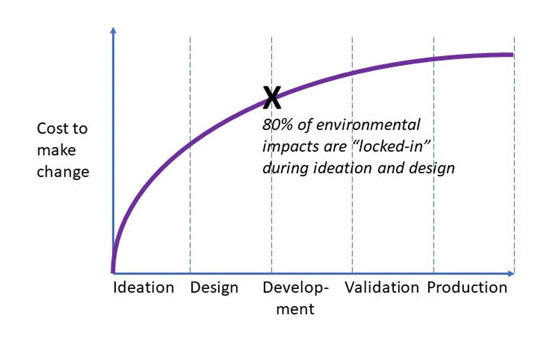
Figure 1: Illustration of environmental impact and product development stages [Adapted from: http://ec.europa.eu/energy/efficiency/ecodesign/eco_design_en.htm]
As shown in Figure 1, however, there is considerably more flexibility to change a system at the early stages of product development in the ideation or design phases. At the ideation stage, changes may only be “on paper” or in a model, a stage where it costs much less to make those changes, or changes may be in materials used at lab scale, before supply chains have been developed and certified. As the product moves through the development phases into design, changes may still be only in drawings, but small changes may require changes to multiple drawings or models. At pilot scale, volumes increase and costs to try different processes or raw ingredients increases.
In the development stage, cost-to-change continues to increase. Materials have been chosen and properties specified. Vendors are evaluated and chosen based on their ability to meet those properties. Capital equipment may have been purchased and land leased or purchased.
Once into validation, the cost to change now includes potential problems with customer expectations, repeated testing, and disruption of upstream and downstream distribution. The social considerations of change expand as the product moves into production to include employees and larger stakeholder groups. Costs now include all of the costs which are associated with each stage at higher scale and with added cost of marketing changes and significant risk to an existing customer base. The further into the development process, the higher the costs of change.
Therefore, typical LCA results are enumerations of environmental impacts that are mostly already locked in because these represent the production phase. While this information is useful for understanding where change to an existing system might make improvements, the opportunity for improvement is marginal. This approach is less useful for guiding development direction or spurring transformative innovations. Yet, to make real progress toward more sustainable systems, the areas of transformative innovations are where companies have the leverage to make the most progress.
Applying traditional LCA to product innovations presents challenges for the practitioner. To be of value, the results must be speculative and reflect possible outcomes. Practitioners are accustomed to life cycle inventory data which is fixed in time, as opposed to a list of possible raw materials, pilot-scale yields which may increase or decrease in production, and energy values that will change both with efficiencies of scale and with the changing grid mix. Emissions may include substances, such as nanoparticles, with poorly characterized environmental impact. For these reasons, Anticipatory LCA has been developed to address these challenges.
The approach of Anticipatory LCA was first formalized in the Journal of Environmental Science and Technology as a featured articled in Wender et al. (2014a) and since then, this concept has evolved to be inclusive of terms such as “ex-ante” and “prospective” (Moni et al. 2019). The latest special issue in the Journal of Industrial Ecology titled Life Cycle Assessment of Emerging Technologies (Bergerson et al. 2020), contains the latest advances in this field. Most of the applications of Anticipatory and prospective approaches to LCA entail emerging technologies evaluated in an academic setting such as incremental sheet forming (Cooper and Gutowski 2018), nanostructured materials (Bartolozzi et al. 2020), nanowires for solar cells (Pallas et al. 2020), hydrogen energy (Shimizu et al. 2020), biobutanol (Nilsson et al. 2020), glass coatings (Tsoy et al. 2019) and photovoltaics recycling (Ravikumar et al. 2015). Other examples include products such as prefabricated building modules (Göswein et al. 2021), 3D printed concrete (Yao et al. 2020) and algae biodiesel (Passell et al. 2013). These examples advance the state of the art of application of LCA for technology development, but they remain challenging to implement in a business setting that moves at a faster pace. In this article, we show how the approach of Anticipatory LCA can be applied in a consulting context to serve business organizations.
Anticipatory LCA offers the opportunity to use environmental impacts as design criteria as early as the ideation phase. The use of stakeholder value assessment, under specification (Olivetti et al. 2013) projections of technological development, characterization factors based on interim data (Eckelman et al. 2012; Wender et al. 2017) and extensive scenario analysis results in insight that can guide the product development phases. This information can provide innovators with valuable insights about directions which would minimize product impact through the life cycle and generate a product with enhanced environmental performance.
This study illustrates the Anticipatory LCA approach for three specific products in different business organizations to demonstrate how business organizations can benefit from incorporating environmental assessment early in the product development stages. The illustrations cover different contexts: from recycling process development, to identifying a preferred operating niche for a technology and for evaluating the environmental potential of a novel biomaterial.
Methods
The issue of applying LCA early in technology development is a topic of concern in several LCA circles, each taking a different name and slightly different approach, but with the shared goal of applying LCA in a more proactive manner to guide technology development. The case studies which follow utilize the approach as first illustrated by Wender et al. (2014a) which has three distinct characteristics: 1) it offers a design oriented approach, rather than an attempt to “predict” the technology pathway. It explores scenarios to identify the pathway to pursue 2) it proposes a comparative analysis so that the technology evaluated is not analyzed in isolation, but in comparison to either other configurations of the technology or the competing conventional technology that it seeks to replace and 3) it is decision oriented and so estimation of uncertainty is essential, in the inventory and weights, and this is used to evaluate the range at which a scenario is preferable as well as to aggregate results into a ranking. Uncertainty here is embraced as it is used to estimate decision confidence. The Anticipatory LCA approach used in EarthShift Global’s consulting follows the general schematic of knowledge flows presented by Wender et al (2014a) and shown here in a simplified fashion in Figure 2:

This figure shows the areas of knowledge needed in an Anticipatory LCA approach that can be classified in four parts. First is the social context which deals with how the technology interfaces with the human system. This includes the system boundaries that are relevant to the study, how the technology affects the market, the functional unit which is often unknown for these technologies and the impact categories to consider, what we think is important to evaluate under each context and important to what extent (the weights).
Then there is the technology model which pertains to the inventory. The inventory for technologies under development is highly uncertain because the manufacturing processes and supply chains have not been established yet. Because these technologies are under constant process optimization, the inventory is constantly changing, and while established manufacturing processes are also changing, these are marginal changes in comparison. For the technology model, one can use the existing lab or pilot data as a benchmark, but then explore possible improvements to the process (like higher yields, more efficient energy use, or a change in additives) or improvements in supporting technologies such as improvements in the sourcing of raw materials or the underlying energy grid. The technology model in these cases, rather than being a detailed account of the current situation, results in a set of sensitivity analyses exploring plausible pathways of development.
The third aspect is the impact assessment, and this is an aspect that in the normal consulting practice does not extend beyond selecting one established impact assessment method (and one additional one for robustness as recommended by ISO). For emerging technologies however, it is possible that certain environmental flows are not captured by existing methods, and so it is necessary to create new characterization factors. These efforts entail further modelling and laboratory work necessary for toxicological studies, which can be out of range for typical consulting work. However, some studies have proposed analytical solutions to that of missing characterization factors (Wender et al. 2017; UCSB 2020), which have been used to integrate into consulting practice.
The first three components – social context, technology model and impact assessment – generate LCA results which are comparative in nature, as Anticipatory LCA uses a benchmark to guide improvements. The benchmark may be the current process or the competing conventional technology. In a comparative LCA it is often the case that there are tradeoffs and as such, the fourth component, is the interpretation of these results that considers uncertainty and preferences into the valuation of results. More specifically, it incorporates a method of ranking alternatives known as stochastic multi attribute analysis (SMAA) (Prado et al. 2017, 2019; Prado and Heijungs 2018), that considers mutual differences and their significance with respect to uncertainty in the ranking of results. This practice deviates from the conventional practice of a creating a single score using a weighted sum based on regional normalization references. These results then provide an indication of the most and least preferable directions for the technology without relying on possibly inaccurate or outdated normalization references.
The Anticipatory LCA process is iterative as shown by the feedback loops represented by the flows of information going from the result interpretation to the modelling components. These feedback loops consist of the identification of parameters that have the most effect in increasing the confidence of the decision as shown by Ravikumar et al (2018). The approach proposed by the Anticipatory LCA framework consists of a global sensitivity analysis of the ranking of results. Therefore, the most relevant parameters are evaluated with respect to the effect on the ranking, and not the individual performance. In the consulting practice, results are not necessarily aggregated into a single score and therefore, feedback loops primarily stem from insight learned in sensitivity analyses. One of the tools from Anticipatory LCA which is used, however, is the evaluation of uncertainty to assess tradeoffs (Mendoza Beltran et al. 2018). This way it is possible to determine whether certain improvements are indeed significant provided propagated uncertainties.
Applying Anticipatory LCA in the consulting context usually does not require all four components discussed above. Application of different components of the approach are discussed in three case studies. The illustrative case studies pertain to different business organizations of different scales and demonstrate how the LCA consulting practice can benefit from a simplified Anticipatory LCA framework (Figure 2) to support clients in the development of their products.
Illustrative case studies
Case studies presented here are organized according to the size of the organization and show different examples of the use of the Anticipatory LCA framework in consulting practice with a varying level of complexity. The first illustration concerns a start-up developing a new biodegradable plastic material to be used in consumer product manufacturing where we applied a form of dynamic LCA to determine a path to equivalency to the conventional non-biodegradable material. The second example is a medium sized enterprise manufacturing off-road tires. Since the disposal of tires was banned in landfills, the organization had to provide a solution for its clients and support them with this burden. This example deals with the implementation of a new recycling process. Here, we fed back to the development team with scenarios that could further improve the process. The third example deals with the largest enterprise, a global technology company exploring the environmental performance of a new technology in additive manufacturing.
Assessment of a biobased material from a start-up company-leveraging the technology model
The first example revolves around a start-up company developing a biodegradable plastic material. Biodegradable plastic has the potential to be a solution for the large amount of plastic waste that ends up in the ocean, so it is of interest for high volume products. The company has proven the process in the research lab and is in the process of refining it for cost, manufacturability, stability of supply chain and other engineering criteria at the pilot scale. Equally important for this company is its environmental footprint which is core to the business offering.
The initial analysis used the process flow from the lab scale production process and compared these with available data from the conventional non-biodegradable material used in the target application. Initial results showed that the lab scale process had significantly higher impact. Using the recommendations from the first screening level results, we asked the company for process and source material changes that they might considering during scale up. We then performed scenario analyses considering those changes. Some of the changes had a negative effect on the results while others showed more promise and these results were not necessarily intuitive to the process engineers. For instance, one of the improvement strategies proposed by the process engineers aimed at reducing wastewater, but this required more energy and thus improvements were marginal. This showed to us that guidance of environmental improvements goes beyond a simple property such as “less waste” or “bio based” and hence a life cycle lens can provide a more assertive guidance. We found that by combining a set of improvement strategies, it was possible to reach an equivalency to the conventional material in addition to the property of biodegrability and in this manner create a strategy going forward. Remembering that LCA cannot yet assess marine litter, this indicates that the product can be an environmental improvement. Assessing marine litter using the impact assessment component of the approach may have provided further clarification in this area but was out of scope of the project. Marine plastic is something that is being addressed in the latest developments in life cycle impact assessment (Peano et al. 2020).
Furthermore, the initial analysis has continued to impact process design decisions through scale-up evaluations and development of next generation technologies since completion of the initial analysis. By prioritizing development of process inputs and unit operations by environmental impact, additional process efficiencies have been realized in chemical inputs, utility requirements as well as decreases in waste by-products and are expected to materially and positively impact relative comparisons to conventional materials.
An environmental solution at a medium sized enterprise-Feedback and global sensitivity analysis
OTR Wheel Engineering (OTR) is an off road tire manufacturer with a large client base in mining and oil and gas developers. Because most states in the US and many foreign countries ban tires from landfills, the large number of tires used by these customers creates both cost and a nuisance. Hearing these complaints, the company’s founder, Fred Taylor, invested in the development of a tire recycling process through a newly formed company called Green Carbon.
The process, unlike prior attempts at tire pyrolysis, successfully resulted in producing fuel oils, steel, and reusable carbon black as well as enough combustible gas to run most of the process. The initial LCA, at pilot scale, showed that the natural gas used to start up the process followed by the electricity used for control and auxiliary function were the highest impacting parts of the product life cycle. Through additional development, the team at Green Carbon were able to sufficiently increase the amount of combustible gas to eliminate the natural gas required to initiate the recycling batch process. Left over combustible gas was channeled to a generator to product some of the electricity requirements of the system.
In addition to traditional greenhouse gas emissions, the original study considered the biogenic component of tires in the resulting fuels based on stakeholder interest.
Follow on work confirmed the reduction in impact from the reduction of outside energy sources but also identified an increase in nitrogen oxides emissions from the combustion of the process gas. With numerous proven technologies available for nitrogen oxide reduction, the company now has another step to take to improve the process before mass commercialization. If Green Carbon would have waited until launching to market, or until its costumers started asking for environmental performance data, it would have been too late in the process to improve the recycling process. By applying LCA early in the developing phase of the recycling process, Green Carbon was able to guide innovations in a way that resulted in better environmental performance – which like in the previous case, it is key part of the business offering.
Spurring a new business model at a Fortune 500 company-combining stakeholder value with dynamic LCA and scenario analysis
Start-up ventures and small/medium sized businesses are not the only clients who benefit from an Anticipatory approach. Work with HP Inc. on their newly commercialized 3D printer resulted in potentially large changes in the company’s approach. An anticipatory LCA specific to HP’s process was combined with a screening level Sustainable Return on Investment of 3D printing in general. This last assessment of stakeholder value provided social context for the overall assessment.
Initial findings showed that the electricity use was a relatively high impact (Figure 3), especially in comparison with conventional technologies like injection molding, was immediately incorporated into the development process. As a result, the next generation printers use significantly less energy than the initial offering. As the actual impact of 3D printing was not known, scenario analysis assessed various possible outcomes, including distributed spares manufacturing, opportunities and benefits of lightweighting, and considering the possibility that 3D printing could extend the life of older cars, dishwashers and other products, spurred innovation (Figure 4).
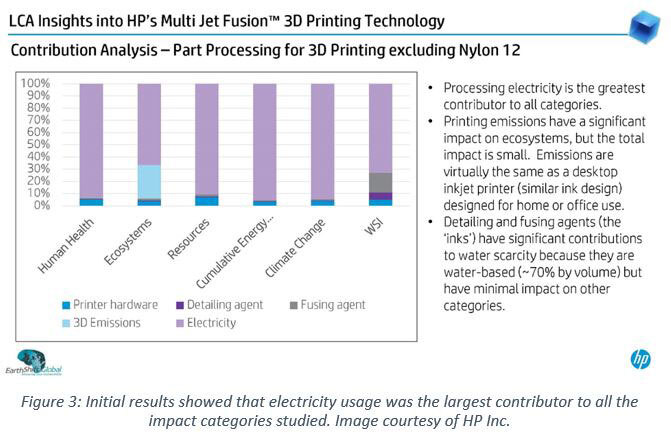
While this last was intended to provide insights into the possible benefits of 3D printing, consideration of the dramatic reduction in impact gave way to the understanding that if HP increased the life of their own equipment, with or without the use of 3D printed parts, they could dramatically reduce impacts of their own products. This insight led the company to consider providing their equipment in a product-service model.
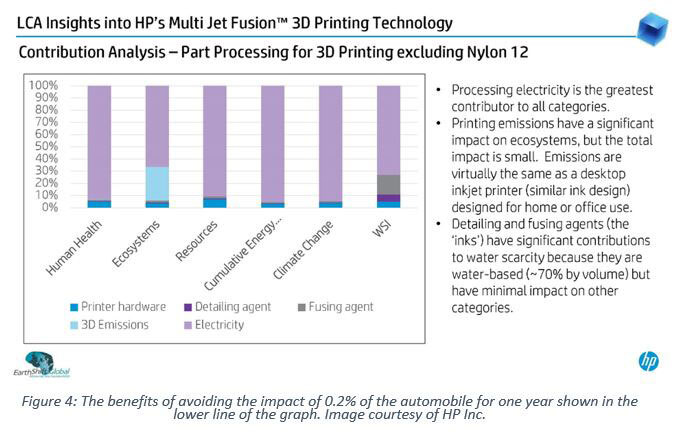
Figure 5 shows the benefits of applying the new business model, of managed print services (MPS) to HP Enterprise printers. For the MPS business model, users would pay for the printing service as opposed to purchasing the device. This meant that HP could now guarantee better use of toner, recovery of used toner cartridges and optimization of printer use to increase double sided print jobs, reduce waste print jobs thus reducing overall life cycle impacts. HP has since launched a portion of their website dedicated to device-as-a-service models and offer commercial PCs, workstations and printers using the model.
This last insight, while developed using the Anticipatory approach for a 3D printer, in fact provided the company with a much broader insight that they could apply across all products.
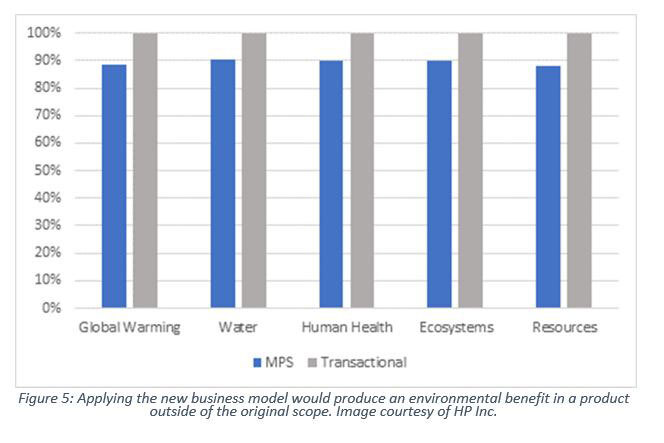
Discussion and Conclusion
Three applications of the Anticipatory LCA approach brought significant value to the study commissioners. While only portions of the method were applied in each case, the additional lens that the approach brought to the business organizations provided insights that would not been possible in a traditional LCA performed once design decisions have taken place. In all three of these cases, the companies learned valuable information that could make their products more marketable while at the same time reducing environmental footprint.
The development of the Anticipatory LCA method has created a way for LCA practitioners to assess new technologies while they are nascent, enabling impact reduction early in the development cycle when it is least costly. While the method has many different ways of handling the uncertainty inherent in this point in the development process, most consulting studies require only one or two adaptations from traditional assessments, such as the Dynamic or scenario assessment. And while the specific technique applied may be quite simple, such as showing a result using 100% wind energy or 100% coal to show both best and worst case, they can provide tremendous value.
A critical part of the process is to ask the right questions. LCA practitioners must already be adept at asking good questions in order to draw inventory data from their clients. Turning that capability to consider what may happen to the product in the future will reap additional rewards. The studies presented in this work show that the Anticipatory approach, developed within academic circles can successfully be transferred to business. This in turn is bringing about meaningful change in innovation of products and business models.
References
Bartolozzi I, Daddi T, Punta C, et al (2020) Life cycle assessment of emerging environmental technologies in the early stage of development A case study on nanostructured materials. 101–115. doi: 10.1111/jiec.12959
Bergerson J, Cucurachi S, Seager TP (2020) Bringing a life cycle perspective to emerging technology “ While the fundamental approach to conducting an LCA of. J Ind Ecol 24:6–10. doi: 10.1111/jiec.12990
Cooper DR, Gutowski T (2018) Prospective Environmental Analyses A Critique , a Proposed Methodology , and a Case Study on Incremental Sheet Forming. J Ind Ecol 24:. doi: 10.1111/jiec.12748
Eckelman MJ, Mauter MS, Isaacs JA, Elimelech M (2012) New Perspectives on Nanomaterial Aquatic Ecotoxicity: Production Impacts Exceed Direct Exposure Impacts for Carbon Nanotoubes. Environ Sci Technol 46:. doi: 10.1021/es203409a
Göswein V, Habert G, Rodrigues C, et al (2021) Using anticipatory life cycle assessment to enable future sustainable construction. 178–192. doi: 10.1111/jiec.12916
Mendoza Beltran A, Prado V, Font Vivanco D, et al (2018) Quantified Uncertainties in Comparative Life Cycle Assessment: What Can Be Concluded? Environ Sci Technol acs.est.7b06365. doi: 10.1021/acs.est.7b06365
Moni MS, Mahmud R, High K, Carbajales-dale M (2019) Life cycle assessment of emerging technologies : A review. J Ind Ecol 24:52–63. doi: 10.1111/jiec.12965
Nilsson A, Shabestary K, Brandão M, Hudson EP (2020) Environmental impacts and limitations of third-generation biobutanol Life cycle assessment of n -butanol produced by genetically engineered cyanobacteria. 205–216. doi: 10.1111/jiec.12843
Olivetti E, Patanavanich S, Kirchain R (2013) Exploring the Viability of Probabilistic Under-Specification To Streamline Life Cycle Assessment. Environ Sci Technol 47:5208–5216. doi: 10.1021/es3042934
Pallas G, Guinée J, Vijver MG, Peijnenburg WJGM (2020) Life cycle assessment of emerging technologies at the lab scale The case of nanowire-based solar cells. 193–204. doi: 10.1111/jiec.12855
Passell H, Dhaliwal H, Reno M, et al (2013) Algae biodiesel life cycle assessment using current commercial data. J Environ Manage 129:
Peano L, Kounina A, Magaud V, et al (2020) Plastic Leak Project: Methodological Guidelines
Prado V, Cinelli M, Haar SF Ter, et al (2019) Sensitivity to weighting in life cycle impact assessment ( LCIA ). Int J Life Cycle Assess
Prado V, Heijungs R (2018) Implementation of stochastic multi attribute analysis (SMAA) in comparative environmental assessments. Environ Model Softw 109:223–231. doi: 10.1016/j.envsoft.2018.08.021
Prado V, Wender BA, Seager TP (2017) Interpretation of comparative LCAs: external normalization and a method of mutual differences. Int J Life Cycle Assess 22:. doi: 10.1007/s11367-017-1281-3
Ravikumar D, Seager TP, Cucurachi S, et al (2018) Novel Method of Sensitivity Analysis Improves the Prioritization of Research in Anticipatory Life Cycle Assessment of Emerging Technologies. Environ Sci Technol 52:6534–6543. doi: 10.1021/acs.est.7b04517
Ravikumar D, Sinha P, Seager TP, Fraser MP (2015) An anticipatory approach to quantify energetics of recycling CdTe photovoltaic systems. Prog Photovoltaics Res Appl n/a-n/a. doi: 10.1002/pip.2711
Shimizu T, Ihara M, Kikuchi Y (2020) A region-specific environmental analysis of technology implementation of hydrogen energy in Japan based on life cycle assessment. J Ind Ecol 24:217–233. doi: 10.1111/jiec.12973
Tsoy N, Prado V, Wypkema A, et al (2019) Anticipatory Life Cycle Assessment of sol-gel derived anti-re fl ective coating for greenhouse glass. J Clean Prod 221:365–376. doi: 10.1016/j.jclepro.2019.02.246
UCSB (2020) Chemical Life Cycle Collaborative. https://clicc.ucsb.edu/
Wender B, Foley RW, Prado-lopez V, et al (2014a) Illustrating Anticipatory Life Cycle Assessment for Emerging Photovoltaic Technologies. Environ Sci Technol 2014:10531–10538
Wender BA, Foley RW, Hottle TA, et al (2014b) Anticipatory life-cycle assessment for responsible research and innovation. J Responsible Innov 1:. doi: 10.1080/23299460.2014.920121
Wender BA, Prado V, Fantke P, et al (2017) Sensitivity-based research prioritization through stochastic characterization modeling. Int J Life Cycle Assess. doi: 10.1007/s11367-017-1322-y
Yao Y, Hu M, Maio F Di, Cucurachi S (2020) Life cycle assessment of 3D printing geo-polymer concrete An ex-ante study. 116–127. doi: 10.1111/jiec.12930
Upcoming Training
Anticipatory LCA - From Concept to Application (3 hrs.)—June 8-9
Anticipatory LCA is an advanced LCA approach designed to improve decision making in the early stages of the design process. LCA researchers have developed several Anticipatory LCA techniques which enable application of LCA early in the research and development phases where uncertainty, but also potential for improvement, is greatest. Anticipatory LCA can be applied as a design tool to explore the environmental variability of alternative technology configurations and applications. This is especially beneficial in the design phases when data is uncertain and fast changing and limits a full traditional LCA.
This course will provide an introduction to the concepts of Anticipatory LCA, and an exploration of the applications of the concepts through industry case studies. In this interactive online course, participants will also have the opportunity to apply Anticipatory LCA concepts to their own case study. Get started applying the concepts to your own situation with an all-star group of instructors: Lise Laurin, Valentina Prado, Tom Seager and Equilibrio co-founder Tom Etheridge.